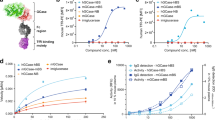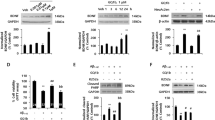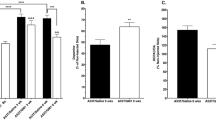Abstract
GM1-gangliosidosis is a lysosomal storage disease (LSD) caused by an autosomal recessive deficiency of lysosomal acid β-galactosidase (βgal). This leads to accumulation of GM1-ganglioside and its asialo derivative GA1 in the central nervous system (CNS), and progressive neurodegeneration. Therapeutic AAV-mediated gene delivery to the brain for LSDs has proven very successful in several animal models. GM1-gangliosidosis is also a prime candidate for AAV-mediated gene therapy in the CNS. As global neuropathology characterizes the most severe forms of this disease, therapeutic interventions need to achieve distribution of βgal throughout the entire CNS. Therefore, careful consideration of routes of administration and target structures from where metabolically active enzyme can be produced, released and distributed throughout the CNS, is necessary. The goal of this study was to investigate the pattern and mechanism of distribution of βgal in the adult GM1-gangliosidosis mouse brain upon hippocampal injection of an AAV vector-encoding βgal. We found evidence that three different mechanisms contribute to its distribution in the brain: (1) diffusion; (2) axonal transport within neurons from the site of production; (3) CSF flow in the perivascular space of Virchow–Robin. In addition, we found evidence of axonal transport of vector-encoded mRNA.
This is a preview of subscription content, access via your institution
Access options
Subscribe to this journal
Receive 12 print issues and online access
$259.00 per year
only $21.58 per issue
Buy this article
- Purchase on Springer Link
- Instant access to full article PDF
Prices may be subject to local taxes which are calculated during checkout




Similar content being viewed by others
References
Okada S, O'Brien JS . Generalized gangliosidosis: beta-galactosidase deficiency. Science 1968; 160: 1002–1004.
O'Brien JS, Stern MB, Landing BH, O'Brien JK, Donnell GN . Generalized gangliosidosis: another inborn error of ganglioside metabolism? Am J Dis Child 1965; 109: 338–346.
Sands MS, Davidson BL . Gene therapy for lysosomal storage diseases. Mol Ther 2006; 13: 839–849.
Skorupa AF, Fisher KJ, Wilson JM, Parente MK, Wolfe JH . Sustained production of beta-glucuronidase from localized sites after AAV vector gene transfer results in widespread distribution of enzyme and reversal of lysosomal storage lesions in a large volume of brain in mucopolysaccharidosis VII mice. Exp Neurol 1999; 160: 17–27.
Sferra TJ, Qu G, McNeely D, Rennard R, Clark KR, Lo WD et al. Recombinant adeno-associated virus-mediated correction of lysosomal storage within the central nervous system of the adult mucopolysaccharidosis type VII mouse. Hum Gene Ther 2000; 11: 507–519.
Passini MA, Watson DJ, Vite CH, Landsburg DJ, Feigenbaum AL, Wolfe JH . Intraventricular brain injection of adeno-associated virus type 1 (AAV1) in neonatal mice results in complementary patterns of neuronal transduction to AAV2 and total long-term correction of storage lesions in the brains of beta-glucuronidase-deficient mice. J Virol 2003; 77: 7034–7040.
Bosch A, Perret E, Desmaris N, Heard JM . Long-term and significant correction of brain lesions in adult mucopolysaccharidosis type VII mice using recombinant AAV vectors. Mol Ther 2000; 1: 63–70.
Bosch A, Perret E, Desmaris N, Trono D, Heard JM . Reversal of pathology in the entire brain of mucopolysaccharidosis type VII mice after lentivirus-mediated gene transfer. Hum Gene Ther 2000; 11: 1139–1150.
Consiglio A, Quattrini A, Martino S, Bensadoun JC, Dolcetta D, Trojani A et al. In vivo gene therapy of metachromatic leukodystrophy by lentiviral vectors: correction of neuropathology and protection against learning impairments in affected mice. Nat Med 2001; 7: 310–316.
Taylor RM, Wolfe JH . Decreased lysosomal storage in the adult MPS VII mouse brain in the vicinity of grafts of retroviral vector-corrected fibroblasts secreting high levels of beta-glucuronidase. Nat Med 1997; 3: 771–774.
Liu G, Martins I, Wemmie JA, Chiorini JA, Davidson BL . Functional correction of CNS phenotypes in a lysosomal storage disease model using adeno-associated virus type 4 vectors. J Neurosci 2005; 25: 9321–9327.
Passini MA, Lee EB, Heuer GG, Wolfe JH . Distribution of a lysosomal enzyme in the adult brain by axonal transport and by cells of the rostral migratory stream. J Neurosci 2002; 22: 6437–6446.
Hennig AK, Levy B, Ogilvie JM, Vogler CA, Galvin N, Bassnett S et al. Intravitreal gene therapy reduces lysosomal storage in specific areas of the CNS in mucopolysaccharidosis VII mice. J Neurosci 2003; 23: 3302–3307.
Luca T, Givogri MI, Perani L, Galbiati F, Follenzi A, Naldini L et al. Axons mediate the distribution of arylsulfatase A within the mouse hippocampus upon gene delivery. Mol Ther 2005; 12: 669–679.
Watson G, Bastacky J, Belichenko P, Buddhikot M, Jungles S, Vellard M et al. Intrathecal administration of AAV vectors for the treatment of lysosomal storage in the brains of MPS I mice. Gene Therapy 2006; 13: 917–925.
Chang M, Cooper JD, Sleat DE, Cheng SH, Dodge JC, Passini MA et al. Intraventricular enzyme replacement improves disease phenotypes in a mouse model of late infantile neuronal ceroid lipofuscinosis. Mol Ther 2008; 16: 649–656.
Broekman ML, Baek RC, Comer LA, Fernandez JL, Seyfried TN, Sena-Esteves M . Complete correction of enzymatic deficiency and neurochemistry in the GM1-gangliosidosis mouse brain by neonatal adeno-associated virus-mediated gene delivery. Mol Ther 2007; 15: 30–37.
Hahn CN, del Pilar Martin M, Schroder M, Vanier MT, Hara Y, Suzuki K et al. Generalized CNS disease and massive GM1-ganglioside accumulation in mice defective in lysosomal acid beta-galactosidase. Hum Mol Genet 1997; 6: 205–211.
Benn CL, Farrell LA, Cha JH . Neurotransmitter receptor analysis in transgenic mouse models. Methods Mol Biol 2004; 277: 231–260.
Taylor RM, Wolfe JH . Decreased lysosomal storage in the adult MPS VII mouse brain in the vicinity of grafts of retroviral vector-corrected fibroblasts secreting high levels of beta-glucuronidase. Nat Med 1997; 3: 771–774.
Swanson LW, Wyss JM, Cowan WM . An autoradiographic study of the organization of intrahippocampal association pathways in the rat. J Comp Neurol 1978; 181: 681–715.
Amaral DG, Witter MP . The three-dimensional organization of the hippocampal formation: a review of anatomical data. Neuroscience 1989; 31: 571–591.
Swanson LW . The anatomical organization of septo-hippocampal projections. Ciba Found Symp 1977; 58: 25–48.
Swanson LW, Sawchenko PE, Cowan WM . Evidence for collateral projections by neurons in Ammon's horn, the dentate gyrus, and the subiculum: a multiple retrograde labeling study in the rat. J Neurosci 1981; 1: 548–559.
van Groen T, Wyss JM . The connections of presubiculum and parasubiculum in the rat. Brain Res 1990; 518: 227–243.
Gonzalo-Ruiz A, Alonso A, Sanz JM, Llinas RR . Afferent projections to the mammillary complex of the rat, with special reference to those from surrounding hypothalamic regions. J Comp Neurol 1992; 321: 277–299.
Luca T, Givogri MI, Perani L, Galbiati F, Follenzi A, Naldini L et al. Axons mediate the distribution of arylsulfatase A within the mouse hippocampus upon gene delivery. Mol Ther 2005; 12: 669–679.
Chen F, Vitry S, Hocquemiller M, Desmaris N, Ausseil J, Heard JM . Alpha-L-Iduronidase transport in neurites. Mol Genet Metab 2006; 87: 349–358.
Blackstad TW . On the termination of some afferents to the hippocampus and fascia dentata; an experimental study in the rat. Acta Anat (Basel) 1958; 35: 202–214.
Raisman G, Cowan WM, Powell TP . An experimental analysis of the efferent projection of the hippocampus. Brain 1966; 89: 83–108.
Passini MA, Macauley SL, Huff MR, Taksir TV, Bu J, Wu IH et al. AAV vector-mediated correction of brain pathology in a mouse model of Niemann-Pick A disease. Mol Ther 2005; 11: 754–762.
Sotelo-Silveira JR, Calliari A, Kun A, Koenig E, Sotelo JR . RNA trafficking in axons. Traffic 2006; 7: 508–515.
Steward O, Ribak CE . Polyribosomes associated with synaptic specializations on axon initial segments: localization of protein-synthetic machinery at inhibitory synapses. J Neurosci 1986; 6: 3079–3085.
Acknowledgements
This work was supported by NIH Grant R21NS053993. We thank Deidre McCarthy for her help with laser capture microdissection, and the Massachusetts General Hospital Neuroscience Center Microscopy and Image Analysis Core (NIH Grant P30NS045776) for use of the laser capture microdissection system and Nikon Supercoolscan 9000 slide scanner.
Author information
Authors and Affiliations
Corresponding author
Rights and permissions
About this article
Cite this article
Broekman, M., Tierney, L., Benn, C. et al. Mechanisms of distribution of mouse β-galactosidase in the adult GM1-gangliosidosis brain. Gene Ther 16, 303–308 (2009). https://doi.org/10.1038/gt.2008.149
Received:
Revised:
Accepted:
Published:
Issue Date:
DOI: https://doi.org/10.1038/gt.2008.149
Keywords
This article is cited by
-
Therapeutic benefit after intracranial gene therapy delivered during the symptomatic stage in a feline model of Sandhoff disease
Gene Therapy (2021)
-
Widespread correction of central nervous system disease after intracranial gene therapy in a feline model of Sandhoff disease
Gene Therapy (2015)
-
Gene Therapy for the Nervous System: Challenges and New Strategies
Neurotherapeutics (2014)
-
Gene Transfer Corrects Acute GM2 Gangliosidosis—Potential Therapeutic Contribution of Perivascular Enzyme Flow
Molecular Therapy (2012)



